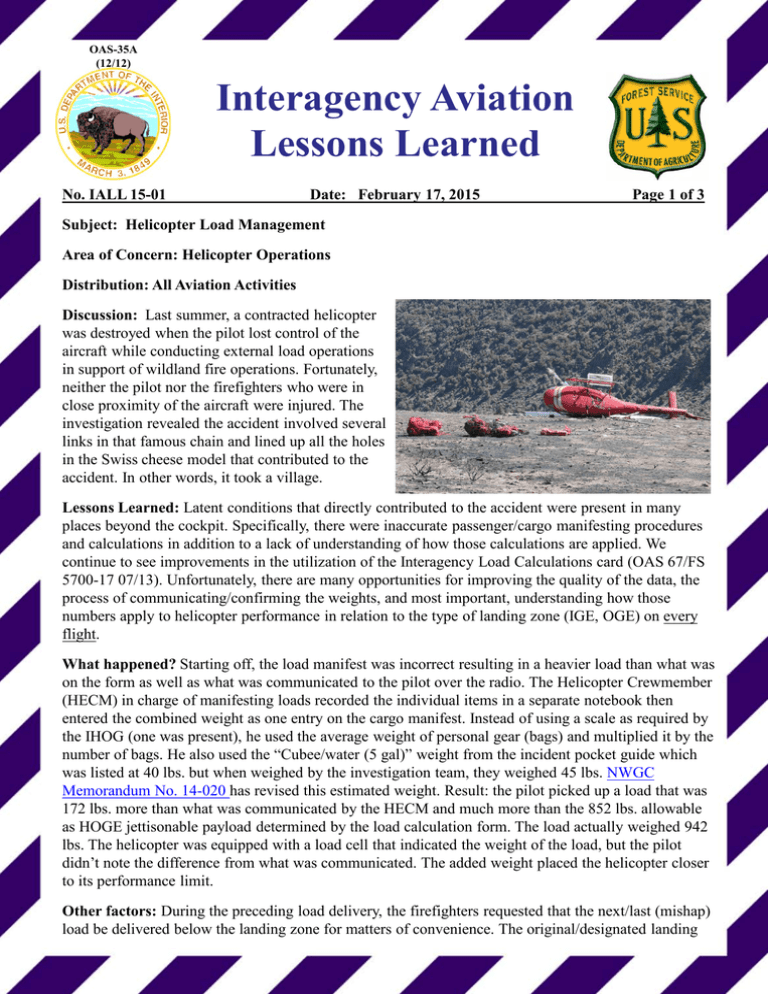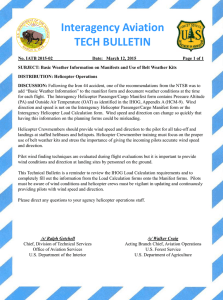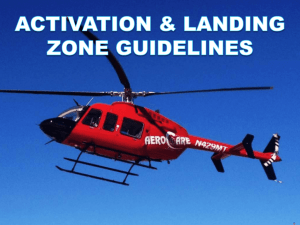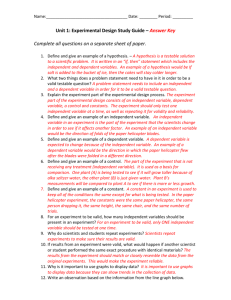Interagency Aviation Lessons Learned
advertisement

OAS-35A (12/12) Interagency Aviation Lessons Learned No. IALL 15-01 Date: February 17, 2015 Page 1 of 3 Subject: Helicopter Load Management Area of Concern: Helicopter Operations Distribution: All Aviation Activities Discussion: Last summer, a contracted helicopter was destroyed when the pilot lost control of the aircraft while conducting external load operations in support of wildland fire operations. Fortunately, neither the pilot nor the firefighters who were in close proximity of the aircraft were injured. The investigation revealed the accident involved several links in that famous chain and lined up all the holes in the Swiss cheese model that contributed to the accident. In other words, it took a village. Lessons Learned: Latent conditions that directly contributed to the accident were present in many places beyond the cockpit. Specifically, there were inaccurate passenger/cargo manifesting procedures and calculations in addition to a lack of understanding of how those calculations are applied. We continue to see improvements in the utilization of the Interagency Load Calculations card (OAS 67/FS 5700-17 07/13). Unfortunately, there are many opportunities for improving the quality of the data, the process of communicating/confirming the weights, and most important, understanding how those numbers apply to helicopter performance in relation to the type of landing zone (IGE, OGE) on every flight. What happened? Starting off, the load manifest was incorrect resulting in a heavier load than what was on the form as well as what was communicated to the pilot over the radio. The Helicopter Crewmember (HECM) in charge of manifesting loads recorded the individual items in a separate notebook then entered the combined weight as one entry on the cargo manifest. Instead of using a scale as required by the IHOG (one was present), he used the average weight of personal gear (bags) and multiplied it by the number of bags. He also used the “Cubee/water (5 gal)” weight from the incident pocket guide which was listed at 40 lbs. but when weighed by the investigation team, they weighed 45 lbs. NWGC Memorandum No. 14-020 has revised this estimated weight. Result: the pilot picked up a load that was 172 lbs. more than what was communicated by the HECM and much more than the 852 lbs. allowable as HOGE jettisonable payload determined by the load calculation form. The load actually weighed 942 lbs. The helicopter was equipped with a load cell that indicated the weight of the load, but the pilot didn’t note the difference from what was communicated. The added weight placed the helicopter closer to its performance limit. Other factors: During the preceding load delivery, the firefighters requested that the next/last (mishap) load be delivered below the landing zone for matters of convenience. The original/designated landing No. IALL 15-01 Date: February 17, 2015 Page 2 of 3 zone was on top of the ridge at an elevation of approximately 9000 feet. The requested landing zone moved the landing area below the ridge where winds were likely to travel downslope. Operating a helicopter with a long line places the helicopter in the environment that is conducive to Loss of Tail Rotor Effectiveness (LTE) due to increased weight and the requirement to HOGE. The pilot was likely experiencing turbulent wind conditions due to the rising terrain in this area. The unstable air mass and surface heating caused moderate winds (10-20 knots) that were measured at the surface. These winds were flowing up over and around the hilltop near the landing area creating updrafts on the windward side of the ridge and downdrafts and turbulence on the leeward side. A demarcation line, or the point that separates the up flow air from the turbulent down flow air, forms at the mountains highest point and extends diagonally upward. The velocity of the wind and slope gradient determines the demarcation line. The higher the wind speed and the steeper the terrain, the steeper the demarcation line angle is and the closer it forms near the crest. This would likely create the turbulent wind conditions near the location that the mishap aircraft would be hovering out of ground effect (HOGE). It’s highly conceivable that the down flowing air reduced performance thus increasing the power required which in conjunction with directional winds, contributed to the onset of LTE. As the aircraft slowed to a hover to deliver the sling load, it began to rotate to the left. The pilot attempted to maintain control and to jettison the load, but was unable. The aircraft rotated several times, lost altitude, and impacted the ground. Figure 1 Wind flow over mountainous terrain contributed to increased performance requirements and the onset of LTE. The goal in recovery is to gain airspeed without increasing power. Decreasing collective (reducing power) also decreases the power required for antitorque. The problem is that these recovery actions will also result in a substantial loss of altitude which may not be an option when operating in close proximity to the ground. Prudent pilot planning should include a clear escape route in these types of conditions/operations. Although it is not included in the AS350 B3e Rotorcraft Flight Manual, jettisoning the load will reduce weight and subsequently reduce the power required. This action should have been accomplished simultaneously along with the other procedures. Repeat Offender. As part of the investigation, all of the helicopter load calculation and manifest forms for that fire were reviewed. The review uncovered many, similar errors as the mishap aircraft for all the helicopters supporting of that fire. Many planned loads were greater than allowable payload weights for conditions, locations, and landing areas (IGE, HOGE, or OGE). No. IALL 15-01 Date: February 17, 2015 Page 3 of 3 Errors of Omission. Most of the errors were simple omissions of required information. There are required items specified by the IHOG such as allowable payload weights for HIGE, HOGE, and HOGEJ. Without the performance data on the manifest, the individual creating the load is unable to correlate payload weight to the actual aircraft performance requirement/ capability as determined by the load calculation and type of operation. Interviews also revealed that some were increasing the available payload by compensating for fuel usage. The only problem was that their figures weren’t being recorded on load calculations or passenger/cargo manifests as directed by the IHOG (Feb 13 – Chapter 7, III.B.2, page 7-3). Your full name here. Another area of concern was that many of the passenger/cargo manifests listed only last names. The passenger manifest may be the only document that can indicate who was actually on an aircraft and used to account for individuals in the event of a mishap involving passengers. The IHOG requires that manifests contain full names. “Standard” Deviation. Individuals often deviate from established standards in order to become more efficient. It appears a lack of perceived negative consequences resulted in a gradual acceptance of these deviations from many. This is called “normalization of deviance.” Individuals across the organization were found to be deviating from a known standard to which it became acceptable. Many times, when people omit steps or requirements, they are rewarded; time is saved, fewer tools are needed, fewer people are needed to do the job, etc. However, in this mishap, failing to adhere to standards set the stage for providing a load that was heavier than anyone expected and was one of the first links in the mishap chain. Complacency that often manifests during numerous routine tasks compounds this problem. Bottom Line. The IHOG and other standards were designed to mitigate the risk of overloading a helicopter. Skipping steps and omitting information on the forms effectively removes safety measures required by those policies. Helicopter Managers and authorized individuals are responsible to complete a manifest for each flight leg flown. Creating accurate passenger/cargo manifests and correlating the actual load weight with the allowable payload weights is a safety measure that must be performed to ensure we are not placing the helicopter in an overloaded condition for the type of operation and landing area. Loads heavier than planned can be identified by either aircraft performance indications (i.e. torque, etc.) or load cell (if installed). Pilots have a responsibility to manage risk and that also means to ensure the quality of the data brought before them is consistent with requirements and expectations. Unfortunately, placing all of that responsibility squarely on the pilot will most often result in failure. In other words, it takes a village. /s/ Keith Raley Chief, Aviation Safety & Program Evaluations DOI, Office of Aviation Services /s/ Gary Sterling Branch Chief, Aviation Safety Management Systems USDA Forest Service





